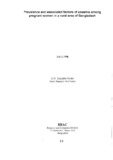Prevalence and associated factors of anaemia among pregnant women in a rural area of Bangladesh
Date
1998-07Publisher
BRAC Research and Evaluation Division (RED)Author
Hyder, S.M. ZiauddinMetadata
Show full item recordCitation
Hyder, S. Z. (1998, July). Prevalence and associated factors of anaemia among pregnant women in a rural area of Bangladesh. Research Reports (1998): Health Studies, Vol - XXV, 13–28.Abstract
This study describes the anaemia prevalence and associated factors among pregnant
women in a rural community in Bangladesh. The study women were recruited from
50 BRAC antenatal care centres. A total of 216 pregnant women during second
trimester of pregnancy were included from rural communities of Mymensingh during
May to November 1997. Information was collected on demographic and
socioeconomic factors, reproductive history, last menstrual period, fundal height, mid
upper arm circumference, haemoglobin concentration as well as ascaris and
hookworm infestations. The result indicates that 56% of the pregnant women were
found anaemic according to the WHO criteria. There was no case of severe anaemia
and the prevalence of mild and moderate anaemia was 22.7'% and 32.9% respectively.
Women 's age, household landholding and occupation categorised as farming and nonfarming
were significantly associated with the anaemia prevalence (p~O . OS) .
Malnourished women in farming households had higher anaemia prevalence.
However, nutritional status was not associated with anaemia prevalence among
women in non-farming households (p>O.OS) Anaemia seems to have very high
prevalence among pregnant women irrespective of their parity and socioeconomic
status. Further studies are required to investigate the causes of anaemia during
pregnancy.

